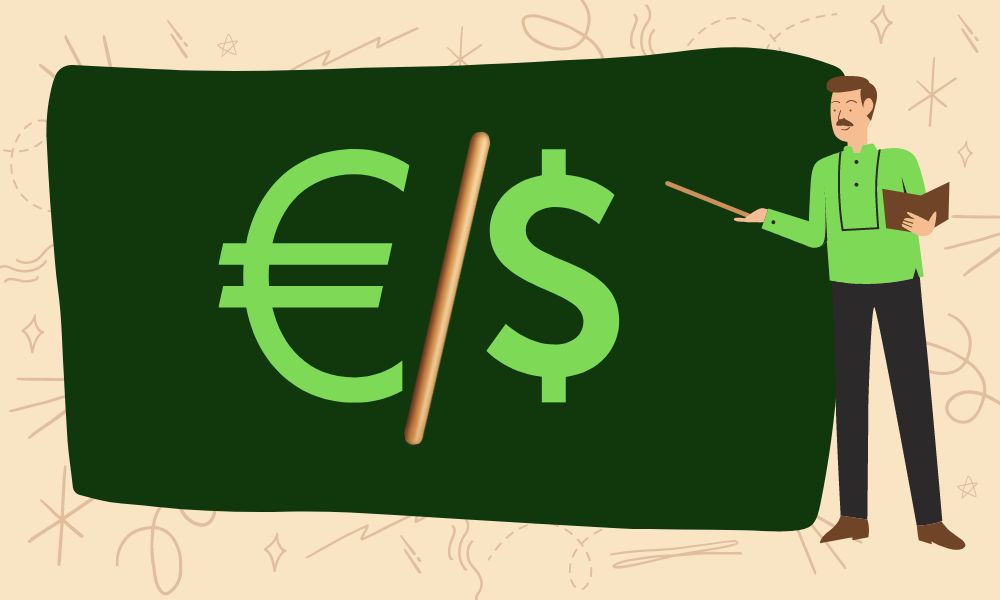The most common currency pair in the history of Forex trading has been the US Dollar against the...

The most common currency pair in the history of Forex trading has been the US Dollar against the Euro.
It's easy to forget that this Forex (FX) pair didn't even exist less than 20 years ago because it is so prevalent today.
This article will give a brief history of the foreign exchange market, with a focus on the EUR/USD currency pair.
Before getting into how the actions of central banks and other factors have changed the historical data for this FX pair, we will first look at where this currency pair came from in the larger history of forex.
The EUR/USD has a remarkable history because it exemplifies the competitive nature of the relationship between the United States and Europe.
Many people study the EUR to USD forecast to understand currency valuation, and trading professionals also study this forecast.
Here, we will focus on the EUR/USD currency's history to see how the pair came to be and how it rose to such prominence in the financial markets.
Before the Euro, many attempts were made in Europe to develop a stable joint economy. The first attempt was made in 1957 under the name European Economic Community (EEC).
Its goal was to unite the economies of six countries: Germany, France, Italy, Belgium, the Netherlands, and Luxembourg.

The next step for the community was the establishment of the European Monetary System (EMS). The EMS began operations in 1979 as a variable exchange rate system.
All European countries benefited from the system's monetary stability. The EMS was later replaced by the European Economic and Monetary Union (EMU).
The value of the Euro against the dollar was initially determined by the value of the European currency unit, which was a symbolic currency based on a basket of currencies from various European countries.
The Euro was introduced to simplify accounting among European countries; however, the currency paper and coins were not rolled out until 2002, when the first 12 E.U. countries officially adopted Euro.
The EUR/USD began at 1.1795 but fell to its lows in 2000 when it stood at 0.8225. It reached a high of 1.6037 in 2008, owing primarily to the US mortgage crisis.
To stimulate the economy, the US aggressively purchased bonds at the time. It is referred to as Quantitative Easing (Q.E.).

For many years, the ECB avoided aggressive bond purchases when the US did. As a result, the Euro may have surpassed the dollar in strength.
Later, when the ECB began its Q.E. program in 2015, the Euro fell once more. During the COVID outbreak, the EUR/USD exchange rate fluctuated dramatically in response to news of COVID cases and vaccination rates.
When the cases started in 2020, the Euro fell against the dollar. To determine the valuation, one must first study the forecast. In general, the EUR/USD is volatile in response to a variety of events.
Government policies such as quantitative easing and events such as the country's debt crisis can have a significant impact on the price of this forex pair.
While the short-term ebb and flow of the Forex EUR USD exchange rate has been influenced by a plethora of factors throughout the history of Forex, the currency pair's long-term performance has been driven by a variety of fundamentals.
Naturally, these are the same factors that have affected currency exchange history as a whole throughout the history of Forex, regardless of which FX pair you look at.
Two significant factors that have affected exchange rates throughout the history of Forex are:
Of course, the latter is inextricably linked to the former. As the timeframes get shorter, speculation becomes more prominent. As a result, expectations about central bank policy have a significant impact.
When we look at the Forex EUR USD exchange rate throughout history, we can see some clear examples. Many of these occurred following one of the largest drops in Euro vs. USD Forex price history:
But here's the catch: the response wasn't consistent. The policy differences between the US Federal Reserve and the European Central Bank (ECB) were particularly pronounced.

The history of the US dollar versus the euro can be as complicated as you want it to be. We have touched on some key areas of Forex's history in this article.
Still, there are many more factors that have affected historical foreign exchange rates and continue to do so in today's Forex markets.
These are some examples:
These are also important factors to consider. We wish you luck in your future trading now that you understand the history of the US Dollar versus the euro and the factors that influence it!
|
HOT TOPICS |
||
 |
||
|
|
||
-1666690795.jpg) |
Why Is It Important To Know About Economic Indicators As A Forex Trader? |